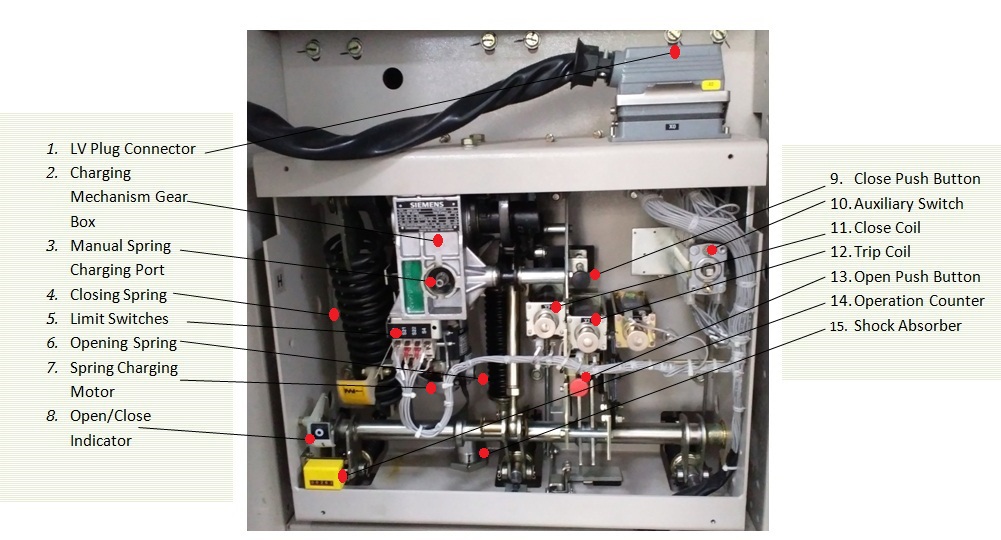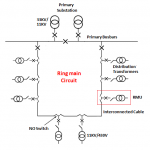In this post, we are going to learn the practical working of a vacuum circuit breaker [VCB] in detail. A vacuum Circuit breaker is used in medium voltage Switchgear for performing switching operations. In Switchgear the VCB is controlled by Electromechanical or Numerical Relays.
Before knowing about Vacuum Circuit breakers, first of all, we will see what the circuit breaker is
Circuit Breaker:
A device used to close/open electrical equipment to the power supply is called Circuit Breaker.
They are named by the cooling or arc quenching media used in the device. When equipment is disconnected from a power supply, the potential strength will be more. This will produce heat in between the surfaces and cause the media to ionize. This is a spark. If the spark continues and it will be called an Arc. The heat energy will damage the device.
To reduce the effect of heat generation, the area provided to the breaker will be increased. The time to separate the equipment from the power supply will be minimized by using a spring. However, the arc can be controlled by cooling or using media that can withstand high potential strength.
Air, Oil, Vacuum, and SF6 gas are some of the quenching media used in a circuit breaker. The breaker is named based on them. They are Air Circuit Breaker (ACB), Oil Circuit Breaker (OCB), Vacuum Circuit breaker(VCB), and SF6 Circuit Breaker.
Vacuum Circuit Breaker VCB:
The vacuum circuit breaker interrupts the current in a vacuum. The contacts of a vacuum breaker are enclosed in a ceramic envelope or “bottle” that is evacuated to extremely low atmospheric pressure, approximately .0023 in. Hg absolute. Although the physics of interruption is quite complex, the vacuum interrupter works because the arc requires a conducting path to sustain it, but within the vacuum bottle there are no gasses to ionize; therefore, for all practical purposes, there can be no conducting path and the arc cannot be sustained.

Vacuum Bottle of Vacuum Circuit Breaker
The figure shows a cutaway view of a single-pole vacuum interrupter. The vacuum bottle has a stationary contact firmly mounted on one end of the enclosure, and a moving contact, which travels a very short distance from the opening to close (1 inch or less), is sealed to the other end of the envelope with a flexible bellow.
Working of Vacuum Circuit Breaker:
The operating mechanism is comprised of the mechanical and electrical components required to:
1. Charge the closing spring with sufficient potential energy to close the circuit breaker and store opening energy in the opening and contact pressure springs.
2. Mechanisms to release closing and opening actions.
3. Means of transmitting force and motion to each of the three pole positions.

Vacuum Circuit Breaker Parts
4. Operate all these functions automatically through an electrical charging motor, cutout switches, anti-pump relay, close coil, open coil, and auxiliary switch.
5. Provide an indication of the circuit breaker status (open/closed), spring condition (charged/discharged), and the number of operations.
The Backside of the VCB consists of Three-phase Contacts and a Vacuum bottle as shown below figure.

Vacuum Circuit Breaker Back View
The Vacuum bottle is placed in between incoming and outgoing contacts of each phase. The incoming contacts (upper side in the figure) receive power from the Busbars. The outgoing contacts (lower side in the figure) deliver power to the loads when the breaker is closed.
Protection for VCB: Using Antipumping Relay
VCBs must be protected from multiple closing and tripping operations. If the breaker closing command is given by the operator breaker tries to close but due to any fault on the protected circuit, the breaker has to trip. Since the closing command is still present, there is a chance of the breaker closing again and being tripped by the relay. This process is iterative and hence continuous command can damage the closing coil of the breaker.
To prevent this situation the breaker operating mechanism is such that the breaker must close for only one close command given by the operator.
For this purpose Anti pumping relay is required. It is a device that prevents the Circuit Breaker from unintentional operation caused by standing or too long operation command pulses.
It is placed inside the circuit breaker or externally as an auxiliary relay.
Anti-pumping Relay Operation:
1. Prevents the CB to re-close after a Close-Open when the close command is too long or continuous. The anti-pump relay is reset by releasing the close command pulse. After this, the CB can be closed again.
2. Prevents the CB to close when a continuous opening command is applied. To reset the anti-pump relay the opening command has to be removed. When performing a trip-free operation (CO without delay) the open command pulse has to be slightly delayed (10-20 ms) to prevent the anti-pump relay to pick up.



![Motor Protection Relays [50/51]:](https://electengmaterials.com/wp-content/uploads/2019/03/motor-protection-relay-150x150.png)
Hi dear company,
I check your products. and your vacuum circuit breaker is very similar to the VCB that we need. but our need is VCB with CYLINDRICAL POLES. please reply me to attach photo and order our VCBs.
Regards.
Dear company
we are a tableau maker in Iran.I have the VCBs with a spring mechanism and cylindrical poles. Please correspond with me so that I can clarify my request with the image.
Regards.
Great article! A vacuum circuit breaker is a type of circuit breaker that uses a vacuum to extinguish the electric arc that forms when the circuit breaker contacts open. The practical working of a vacuum circuit breaker involves the use of a vacuum interrupter, which is a sealed chamber containing contacts and a vacuum. When the contacts open, the vacuum prevents the formation of an electric arc, which can damage the contacts and surrounding components. This makes vacuum circuit breakers highly reliable and suitable for use in high-voltage power systems. Understanding the practical working of vacuum circuit breakers is important for electrical engineers and technicians who work with power distribution systems.